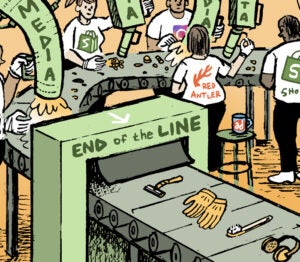 With the midterm elections less than 24 hours away, some of the Democratic Party’s top digital advertising evangelists are worried that liberal candidates have squandered opportunities by siloing digital media and failing to adequately spend online.
With the midterm elections less than 24 hours away, some of the Democratic Party’s top digital advertising evangelists are worried that liberal candidates have squandered opportunities by siloing digital media and failing to adequately spend online.
Conservative groups account for seven of the ten highest-spending political advertisers on Google and Facebook, according to data collected by New York University researchers. On Google in particular, Dems are being outspent by an almost four-to-one margin.
“We’re still seeing media mixes that do not reflect where people spend their time and how they consume media,” said Mark Jablonowski, CTO of the liberal ad tech company DSPolitical. “Most candidates have a media plan similar to what we saw in 2016 or 2014.”
Digital fundraising has helped Democrats keep pace with conservative committees and super PACs, said Will Johnson, SVP of advertising at the liberal media and activism company Daily Kos. “But that hasn’t translated to views on digital for other important tactics.”
The problem, Johnson said, is that Democrats view online ads as a vehicle for fundraising and data acquisition, but haven’t used them yet for persuasion or mobilization.
Online Persuasion
While Republicans and the Trump campaign group heavily promote videos about hot-button topics to raise awareness, Johnson said Democrats usually promote online videos for fundraising.
He also believes Republicans have done a better using social media and programmatic to target people who are heavy news consumers with messages they want amplified online.
The Dems haven’t been able to replicate this strategy as effectively, since high-spending candidates for Senate and governorships tend to buy digital media through media strategists and TV buying agencies, said Keegan Goudiss, managing partner of the liberal digital advertising agency Revolution Messaging.
So a television commercial might have some online pre-roll inventory thrown in, but Dems don’t think of using online video as the primary medium for a persuasion campaign.
“The people who support the strategic value of TV have won with Democratic campaigns this cycle,” Goudiss said.
AdExchanger Daily
Get our editors’ roundup delivered to your inbox every weekday.
Daily Roundup
Digital media messaging “hasn’t echoed with the higher echelons of the party,” Johnson said.
By contrast, Republicans have promoted their digital experts. Brad Parscale went from digital media director of the Trump campaign in 2016 to campaign manager for the 2020 reelection campaign, and digital advertising executives have become budget decision makers for top-spending Republican political committees.
Democrats haven’t followed suit because despite being interested in digital campaigns, many liberal consultants and media strategists don’t believe online video produces the same emotional reaction as a TV spot, Goudiss said.
While Beto O’Rourke’s (D-TX) Senate campaign invested more in digital than any campaign this year on either side of the aisle, the campaign’s big online fundraising drive in the home stretch is getting spent on TV.
“It’s a little frustrating even with Beto because you don’t want digital to be only thought of as a DR channel for fundraising and email list-building,” one media planner for the O’Rourke campaign told AdExchanger last month.
Digital Disconnects
Even money raised on digital isn’t being invested in digital outreach.
“We’ve had more money as a party this year than anyone can remember and are raising hand over fist online, but that money isn’t going back to digital much of the time,” Jablonowski said. “There’s a disconnect with the people making media plans.
Democrats are also spending more on campaign groundwork this year, like paid community organizers and tech for canvassing, Goudiss said. And that’s all well and good, he said, but it doesn’t explain why many top Dems have scaled back digital as a percent of media or limited online ad campaigns to search and social with the big platforms.
“I worry that the wrong takeaway could come out of the election if there are broad Democratic wins and digital ends up being boxed in for another cycle,” Jablonowski said.
But that’s the good problem to have.
“Those of us in the digital space are concerned,” Goudiss said. “There’s a sense Democrats could snatch defeat from the jaws of victory.”













